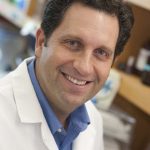Paul Allen Family Foundation Awards Grant to Grow Lung Tissue, Lungs
The Paul G. Allen Family Foundation awarded $1.3 million over three years to three BU faculty for a project aimed at growing lung tissue and lungs in the lab.
 Darrell Kotton, MD, the David C. Seldin Professor of Medicine, together with ENG’s Associate Professor of Biomedical Engineering Wilson Wong, PhD, and Professor of Biomedical Engineering and Materials Science & Engineering Christopher Chen, MD, PhD, developed the proposal, along with postdoctoral fellow Ian Kinstlinger, to investigate how our lungs develop the complicated branching structures that allow for the exchange of oxygen and CO2.
Darrell Kotton, MD, the David C. Seldin Professor of Medicine, together with ENG’s Associate Professor of Biomedical Engineering Wilson Wong, PhD, and Professor of Biomedical Engineering and Materials Science & Engineering Christopher Chen, MD, PhD, developed the proposal, along with postdoctoral fellow Ian Kinstlinger, to investigate how our lungs develop the complicated branching structures that allow for the exchange of oxygen and CO2.
The award is one of 11, totaling $15.5 million, given to 23 researchers from around the world by the foundation established by the late Microsoft co-founder Paul G. Allen as part of the Allen Distinguished Investigators program, which targets nontraditional, ambitious research in biology and medicine.
Kotton said the hope is that it will ultimately lead to medicines and treatments targeted to specific patients that may help fight some of the world’s most pernicious diseases like lung cancer and pulmonary fibrosis.
The project combines Kotton’s work on stem cells as director of the Center for Regenerative Medicine, Wong’s research into programming cellular circuits and Chen’s expertise on engineering cellular microenvironments as founding director of the Biological Design Center.
“The lung’s branching fractal structure is very energetically efficient for delivering oxygen,” says Wong. “The question is, how do the cells decide to form tubes and then keep branching into tinier tubes?”
That’s something that Kotton, in collaboration with researchers at BU and other universities and hospitals, has been investigating for 18 years. He compares stem cell research on lung tissue regeneration to astrophysicists following the long trail of starlight, rewinding time back to the Big Bang. It took years investigating the stem cells in the inner layers of the developing human embryo to find that moment when they differentiated from other cells and ultimately formed the lungs.
“The human cells we can engineer now are more representative of the involved cell types and this allows us to bring more cell types into models to more faithfully represent lung tissue,” said Kotton.
The funding will help pay for training, material, cell culture medias and molecular engineering, he said.
“Success would be producing a multicellular structure that pulmonary doctors and researchers would recognize as lung tissue,” Kotton said. His part of the project will be to turn human stem cells into lung cells that can be introduced into models based on branching pattern theories of how fractal structures like feathers develop.
“It’s risky because we have to build a lot of things from scratch,” said Wong. “But that’s what we do in synthetic biology.”
View all posts